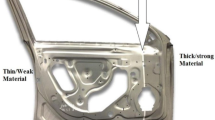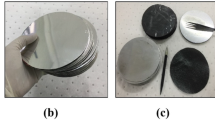Abstract
Forming process and product quality in hydroforming of sheet metal have been considered to be significantly influenced by numerous technological parameters, and one of those is blank holder pressure. This parameter keeps an important role in not only maintaining stability on rim of workpiece but preventing leakage of high-pressure liquid as well. In this paper, a parametric study was conducted to investigate a relationship between the blank holder pressure and forming pressure during the shaping process. Moreover, effect of the blank holder pressure on product quality was also experimentally scrutinized through thinning and real shapes of different finished products. The researched object was chosen to be a cylindrical cup made of steel DC04 with various thicknesses. The experiments were implemented for two cases of the blank holder pressure during forming process: constant and varied pressures. The results indicate a covariant relationship between the blank holder pressure and forming pressure. Furthermore, it should be noted that the forming pressure can be maintained at higher values in the case of varied blank holder pressure, thereby improving shape quality and thinning rate of the product. The relationship between two types of pressure as well as impact of the blank holder pressure on the bottom radius and the maximum thinning of the product is demonstrated as functions through empirical studies. This study is believed to make contribution to optimizing technological parameters within forming process to manufacture high-quality products.
Graphical Abstract















Similar content being viewed by others
Abbreviations
- CBP:
-
Constant blank holder pressure
- d:
-
Diameter of die (mm)
- Ft :
-
Tabulated value according to Fisher criterion
- Fα :
-
Adequacy according to Fisher criterion
- h:
-
Depth of die (mm)
- N:
-
Total number of experiments
- n0 :
-
Number of repetitions in plan central.
- nk :
-
Number of change of variables
- nα :
-
Number of symmetrically positioned points at plan central.
- P:
-
Forming pressure (bar)
- Pmax :
-
Maximum forming pressure (bar)
- Q:
-
Blank holder pressure (bar)
- s0 :
-
Thickness of workpiece (mm)
- smin :
-
Minimum thickness on the product
- VBP:
-
Varied blank holder pressure
- x 1 :
-
Coded variation of blank holder pressure
- x 2 :
-
Coded variation of workpiece thickness
References
Hartl, C. (2005). Research and advances in fundamentals and industrial applications of hydroforming. Journal of Materials Processing Technology, 167(2–3), 383–392. https://doi.org/10.1016/j.jmatprotec.2005.06.035
Lihui, L., Kangning, L., Cai, G., Yang, X., Guo, C., & Bu, G. (2014). A critical review on special forming processes and associated research for lightweight components based on sheet and tube materials. Manufacturing Review, 1, 9. https://doi.org/10.1051/mfreview/2014007
Oh, S.-I., Jeon, B.-H., Kim, H.-Y., & Yang, J.-B. (2006). Applications of hydroforming processes to automobile parts. Journal of Materials Processing Technology, 174(1), 42–55. https://doi.org/10.1016/j.jmatprotec.2004.12.013
Tolazzi, M. (2010). Hydroforming applications in automotive: A review. International Journal of Material Forming, 3(S1), 307–310. https://doi.org/10.1007/s12289-010-0768-2
Bakhshi-Jooybari, M., Gorji, A., & Elyasi, M. (2012). Developments in sheet hydroforming for complex industrial parts. Metal Forming – Process, Tools, Design, 3, 55–84.
Hu, H., Wang, J.-F., Fan, K.-T., Chen, T.-Y., & Wang, S.-Y. (2015). Development of sheet hydroforming for making an automobile fuel tank. Proceedings of the Institution of Mechanical Engineers, Part B: Journal of Engineering Manufacture, 229(4), 654–663. https://doi.org/10.1177/0954405414554666
Lang, L., Danckert, J., Nielsen, K., & Zhou, X. (2005). Investigation into the forming of a complex cup locally constrained by a round die based on an innovative hydromechanical deep drawing method. Journal of Materials Processing Technology, 167, 191–200.
Cezarina-Afteni, G.-A.C., Iacob, I., Păunoiu, V., & Baroiu, N. (2018). An overview on sheet metal hydroforming technologies. The Annals of “DUNĂREA DE JOS” Iniversity of Galati Fascicle V, Technologies in Machine Buiding, 36, 55–62.
Bell, C., Corney, J., Zuelli, N., & Savings, D. (2019). A state of the art review of hydroforming technology. International Journal of Material Forming. https://doi.org/10.1007/s12289-019-01507-1
Saeed Tamimi, C. B., Corney, J., Savings, D., Zuelli, N. (2016). Research directions in hydroforming technology. In Paper presented at the AIP conference proceedings.
Zhang, S. H., Wang, Z. R., Xu, Y., Wang, Z. T., & Zhou, L. X. (2004). Recent developments in sheet hydroforming technology. Journal of Materials Processing Technology, 151(1–3), 237–241. https://doi.org/10.1016/j.jmatprotec.2004.04.054
Koller, D., & Ulbrich, S. (2011). Optimal control of hydroforming processes. PAMM, 11(1), 795–796.
Pepelnjak, T. (2004). Numerical Analyses of Tube Hydroforming by High Internal Pressure. Strojniski Vestnik - Journal of Mechanical Engineering, 50(1), 31–43.
Yuan, S. (2021). Fundamentals and processes of fluid pressure forming technology for complex thin-walled components. Engineering, 7(3), 358–366. https://doi.org/10.1016/j.eng.2020.08.014
Chen, Y. Z., Liu, W., Zhang, Z. C., Xu, Y. C., & Yuan, S. J. (2017). Analysis of wrinkling during sheet hydroforming of curved surface shell considering reverse bulging effect. International Journal of Mechanical Sciences, 120, 70–80. https://doi.org/10.1016/j.ijmecsci.2016.10.023
Taye, F. F., & Ravi, K. D. (2019). Enhancement of drawability of cryorolled AA5083 alloy sheets by hydroforming. Journal of Materials Research and Technology, 8(1), 411–423. https://doi.org/10.1016/j.jmrt.2018.02.012
Karabegović, E., & Poljak, J. (2016). Experimental modeling of fluid pressure during hydroforming of welded plates. Advances in Production Engineering and Management, 11(4), 345–354. https://doi.org/10.14743/apem2016.4.232
Gagov, V., Tomoc, B., Radev, R., & Yankov, E. (2009). About the sheet metal testing by hydraulic bulging. International Journal of Microstructure and Materials Properties, 4, 640–648.
Marandi, F. A., Jabbari, A. H., Sedighi, M., & Hashemi, R. (2017). An experimental, analytical, and numerical investigation of hydraulic bulge test in two-layer Al–Cu sheets. Journal of Manufacturing Science and Engineering, 139(3), 10. https://doi.org/10.1115/1.4034717
Modi, B., & Kumar, R. (2019). Optimization of process parameters to enhance formability of AA 5182 alloy in deep drawing of square cups by hydroforming. Journal of Mechanical Science and Technology, 33(11), 5337–5346. https://doi.org/10.1007/s12206-019-1026-2
Nguyen, T. T., & Nguyen, T. D. (2020). On the high fluid pressure in hydrostatic forming for sheet metal. International Journal of Precision Engineering and Manufacturing, 21(12), 2223–2233. https://doi.org/10.1007/s12541-020-00426-5
Modi, B., & Kumar, D. R. (2012). Development of a hydroforming setup for deep drawing of square cups with variable blank holding force technique. The International Journal of Advanced Manufacturing Technology, 66(5–8), 1159–1169. https://doi.org/10.1007/s00170-012-4397-4
Kumar, R. U., Reddy, P. R., & SitaRamaraju, A. V. (2012). Determination of blank holder pressure in hydroforming deep drawing process. International Journal of Mechanical Engineering and Robotics Research, 1, 242–249.
Kumar, R. U. (2020). Numerical analysis of blank holder pressure in deep drawing. International Research Journal of Engineering and Technology, 7(11).
Shulkin, L. B., Posteraro, R. A., Ahmetoglu, M. A., Kinzel, G. L., & Altan, T. (2000). Blank holder force (BHF) control in viscous pressure forming (VPF) of sheet metal. Journal of Materials Processing Technology, 98(11), 7–16. https://doi.org/10.1016/S0924-0136(99)00300-3
Dougherty, C. (2002). Introduction to econometrics (2nd ed.). Oxford: OUP.
Acknowledgements
This research is funded by Hanoi University of Science and Technology (HUST) under Project number T2022-PC-019.
Author information
Authors and Affiliations
Contributions
TNT: analysis of experimental data, and design of design and manufacture of a complete the experimental system; writing the original manuscript. TND: writing and editing the manuscript. All authors read and approved the final manuscript.
Corresponding author
Ethics declarations
Competing interests
The authors declare that they have no competing interests.
Additional information
Publisher's Note
Springer Nature remains neutral with regard to jurisdictional claims in published maps and institutional affiliations.
Supplementary Information
Below is the link to the electronic supplementary material.
12541_2022_740_MOESM1_ESM.xlsx
Determination of the regression function of the forming pressure was performed according to the orthogonal second order design method, and the sequence is provided in Additional file 1
Rights and permissions
Springer Nature or its licensor (e.g. a society or other partner) holds exclusive rights to this article under a publishing agreement with the author(s) or other rightsholder(s); author self-archiving of the accepted manuscript version of this article is solely governed by the terms of such publishing agreement and applicable law.
About this article
Cite this article
Nguyen, T.T., Nguyen, T.D. A Study on the Impact of Blank Holder Pressure on Forming Pressure and Product Quality in Hydrostatic Forming. Int. J. Precis. Eng. Manuf. 24, 187–198 (2023). https://doi.org/10.1007/s12541-022-00740-0
Received:
Revised:
Accepted:
Published:
Issue Date:
DOI: https://doi.org/10.1007/s12541-022-00740-0




